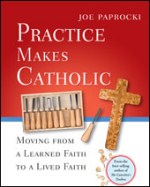 Recently I had the opportunity to listen to author and national consultant, Joe Paprocki, give a workshop on Catholic identity. In his delightfully engaging style, Joe invited his audience to reflect on their own experiences in order to identify for themselves what it means to be authentically Catholic. Participants shared a variety of rituals, symbols, and gestures that reflect a uniquely Catholic experience. During the remainder of the day, Joe helped us draw deeper meaning from those experiences, enabling participants to get to the heart of what it means to be Catholic.
Recently I had the opportunity to listen to author and national consultant, Joe Paprocki, give a workshop on Catholic identity. In his delightfully engaging style, Joe invited his audience to reflect on their own experiences in order to identify for themselves what it means to be authentically Catholic. Participants shared a variety of rituals, symbols, and gestures that reflect a uniquely Catholic experience. During the remainder of the day, Joe helped us draw deeper meaning from those experiences, enabling participants to get to the heart of what it means to be Catholic.
From the enthusiastic responses, it seemed most in the room could relate to the images and memories shared, even though our “vintage” spanned several decades. I wondered, though, could the same be said for the young families we serve? What faith experiences unite them? Often times I find young Catholic families are struggling to identify what it means to be Catholic today. As a parish minister, I need to be sensitive to how my own experiences may be much different from theirs. What are the constants of Catholic identity, and how does this translate for young Catholics?
In his book, Practice Makes Catholic, Joe Paprocki identifies five key characteristics that define what it means to be Catholic. I encourage you to consider what these characteristics look like for the young parents and children you serve.
- A sense of sacramentality—Today’s families may not have holy water fonts in each room or pray the rosary as a family. They may not know what a novena is. They may be clueless to the rhythm of the liturgical year. They will have palms, be familiar with ashes, and may use an Advent wreath. This year I invited families to learn about the Epiphany blessing of the home and provided chalk, a prayer, and instructions. How can you share the depth and meaning of ritual and symbol with families in non-threatening ways?
- A commitment to community—Young families understand and crave community. They belong to school communities, athletic teams, and neighborhood groups. They may not feel connected to the Catholic community. Is your parish or school a welcoming place? Do you know one another by name? Do you know what parents do for a living, or what gifts and talents they have? Look for ways to include families in parish events and for families to interact and support one another.
- Respect for human life—How we treat one another and how we think about the value of each person should reflect Gospel values. Being Catholic means being people for others. But are we always? Where in parish, school, or family life does this characteristic break down?
- Reverence for Scripture and Tradition—Yes, there really is a core of Catholic knowledge and belief, and we must continue to hold up the bar. Catholics need to learn and remember the teachings of the faith.
- An attitude of faith and hope—In spite of life’s challenges, a Catholic turns away from despair and seeks comfort in the faith and the community. Knowing one another and being there to encourage and support each other in difficult times reminds us that we do not journey alone. In what ways do parents and students receive our support through life’s difficulties?
There really is something special about being Catholic, and those of us in ministry are constantly striving to share what we have with those we serve. Our task is to communicate effectively to our students and their families, in ways that makes sense for them.
You might also be interested in the Practice Makes Catholic webinar recording.





Thank you for this article… A great help for me as an educator in a Catholic institution..